#mitakuye oyasin
Text
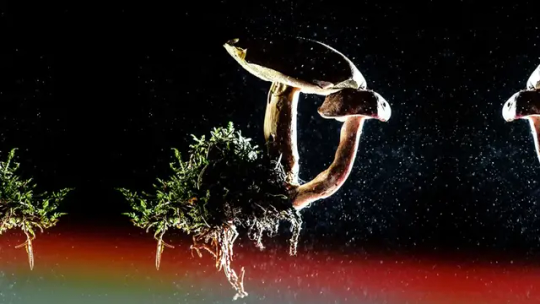
Queering the Wild by Micha Rahder (2019) [final]
Queer Intimacy in Non-Human Animals
The author introduces several examples of ‘queerness’ across the animal kingdom—the ‘birds and the bees’, --a lot about birds since we have a lot of research on them. The study on zebra finches reminded me of the concept of ‘naturecultures’; they choose their mates and often do not stray, same-sex or otherwise and so this supports the idea that there is more to ‘bird life than breeding and that the social aspects of bonding might be just as important’ (02).
“The idea that sexual activity might be about more than just making babies is hard for people who were raised in contemporary U.S. American culture in particular, with its focus on abstinence-only sex ed and heavy legislation of uteruses and the people who have them” (02) but finches, bonobos, dolphins or ‘female fish that prefer males that have had sex with other males, all chip away at that anthropocentric frame’ (02).
“Because scientists carry their cultural biases into their work, most research approaches these kinds of queer traits and behaviors as problems to be solved” (02). Heteronormativity has made scientists ‘run in circles’ trying to explain why such ‘maladaptive’, ‘perverted’ traits appear throughout the natural world such as nutritional deficiencies, the stress of captivity, that they’re just ‘dumb’ and can’t tell the difference, it’s a ‘misfire’ attempt at heterosexuality, or they’re just ‘practicing’.
“Evolutionary biologists need to think about same-sex sexual behavior in non-human animals as more than just a problem to be solved” and “same sex sexual behavior is both a trait that is potentially shaped by selection and a force that shapes selection on other traits” or they should “consider how same-sex sexual activities shape ongoing evolutionary processes” (03).

Extending Our Chosen Family
Evolution has no “direction or purpose” and humans are not “the representation of the ultimate expression of life on earth” (03). If we look at microbiology, we can see true diversity. “Only recently have scientists started to pay attention to how much [microbes exchanging DNA] might be driving evolution” (03). Fungi are also an incredible example of sexual diversity; with one species alone having more than 23,000 documented mating types (sexes) and individuals can physically ‘merge or separate in different environmental contexts’ making it difficult to differentiate them.
‘Symbiopoesis’ or “how organisms can be intimately involved in each other’s development” (squid and light emitting bacteria, bees and pollination, acacia trees and ants, wasps and figs).(03) Again this reminds me of the Lakota concept of Mitakuye Oyasin—we are all related, all my relatives.
Competition//Cooperation is another binary that queer ecology can challenge.
“Queering nature means learning about our connectedness with all the living earth. Here, the classic queer recognition of chosen family extends beyond humans, recognizing our kinship and interdependence with our companion animals, the foods we eat, our microbes and others. It means taking pleasure in those connections, learning to recognize pleasure in others and understanding how our human identities, gender expressions and sexual behaviors are only a small piece of the wide, queer living world” (04).
Queer ecology asks us to be curious about the ‘magnificent overabundance of reality’ (Bagemihl). “Breaking free from the historical biases of science allows us to move forward together with other life on earth, rather than thinking ourselves as separate from or above it. That kind of hierarchical thinking has kept queer and other marginalized communities away from the benefits of being outdoors and has led directly to the tangle of global environmental crises in which we find ourselves now. Learning from non-humans is a great way to undo these legacies” (04).
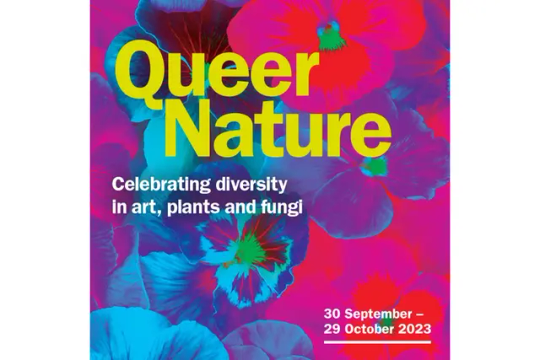
#queering the wild#queer ecology#queer nature#ecofeminism#heteronormativity#queer theory#critical ecology#environmental politics#ecology#queer history#mitakuye oyasin#evolution#naturecultures#Symbiopoesis
37 notes
·
View notes
Text
An Important PSA
Now, I am just a grumpy fat, old nerd in the middle of nowhere who really believes in the Force, going through all kinds of health and financial issues, so you can take this all with grain of salt now. Maybe you need more than a little, but that's fine with me.
I have watched a great many of you for a while. I see the trials you go through at school. Watching as your family rejects who YOU say you are. Some friends have just abandoned some of you because of a million stupid reasons. There have been many who discovered they have Tourette's, Dyslexia, and ADHD like me. Others got the bad news, much like me, and have EDS, Fibromyalgia, and more, and are getting all too familiar with running out of spoons, or having your nervous system just close down with pain because it cannot take any more.
I know how much that hurts emotionally. I've been there, and whether I like it or no, that is the place my tookus is parked in the material. There's treatment to slow it down, but no cure. But, you've probably noticed, other than an occasional grouch, you don't see a lot of negative behavior on my end. Why? Well, here's what I tell myself, and I am telling you.
You do not owe anybody anything whatsoever. You don't owe your parents to fit their imaginary version of you. You don't owe your family to be like anyone else. Certainly you don't owe your friends your time at the drop of a hat! Real friends can lose touch for half a decade and pick up right where they left off. No pastor, Priest, or pop icon has any right to determine how you will be. That belongs to you, and you alone.
And Force help me, you certainly don't owe some commentator or political personality your identity, your devotion, or your money. That goes doubly true for some random asshole on the internet, including yours truly. We have no business dictating lifestyle choices, careers, or any other tarn burned things to you. Ordering your life is your decision, and everything good or bad you will ever say, be, or have starts and ends inside of you, and nowhere else.
If you want to know if something is good or true, ask yourself these questions
What would I feel if I were coming at this as another person?
Does it make me healthier? Wiser? Kinder?
And the easiest version comes from the CWG books..
What would Love do next?
Use those, and you'll rarely go astray.
So, put this blasted phone or laptop down, go take a breath of fresh air, and start on the biggest adventure of all: being the real you. May you never be the same again.
#just saying#just the facts#just being honest#just a thought#just roll with it#the absolute truth#there is always hope#mitakuye oyasin#we are all related#we are always stronger together#it gets better
1 note
·
View note
Text
A basic principle of the indigenous world view is that all things in the universe are connected. We believe that we are a part of everything and that everything in the natural world is alive—conscious—even the stones, the Earth, the stars.
Spencer Martin
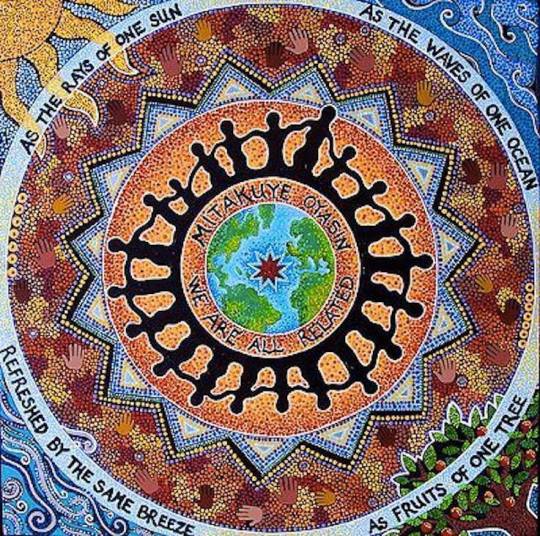
art by Mitakuye Oyasin
159 notes
·
View notes
Text
As a general heads up, I'm so tired of Native Americans getting no good representation in media; if you EVER want to make a character in anything you're doing and you want them to be proper Native hit me up. I can gleefully assist you on writing them or actually help you make them Native (at least within the confines of my understanding which means I can assist with making them Lakota, but in that case more power to you for actually giving them a real tribe and history.)
I'm really tired of the horrible representation we get.
I'm really tired of the way we are seen and portrayed.
I'm really tired of how our issues that we actually care about are ignored in favor of the old tried and true "we want our land back" story, which while true; is not at all the only thing we care about.
I'm tired of the narrative that we're a lost cause, that we're not worth fighting for, that we're already dead.
I'm tired of the fact the best representation of us that a friend of mine gave me when I said we have no representation was "there's a Native dude in Mortal Kombat!" OH YEA DUDE THAT'S FUCKING ACCURATE SURE! YEA MY UNCLE ALSO SUMMONS LIGHTNING AND BECOMES A FUCKING ANIMAL!
So yea believe me, you have no idea how cool it is when someone makes Native shit especially Lakota stuff!
One of my favorite artists is edrw and I cannot urge you enough to check out their stuff! Clicking their name there will take you to their deviantart and they do REALLY cool Lakota/Native inspired art.
If you're worried about it being offense run it by me, if you're worried about it not being accurate; I'm here for you fam.
Mitakuye oyasin, my friends.
47 notes
·
View notes
Text

Charles Burchfield
* * * *
My grandma told me that the Universe is singing in the snowflakes, the raindrops, in the trees, the water, and all Creation. Physicists call this holistic holographic universe. Lakotas call it Taku Wakan Skan Skan/Mitakuye Oyasin, which means everything is connected and related in divine rhythm, vibration. Remember the Lakotas know that the song sings the singer. The Spirit sings the song.
~ Basil Braveheart
[alive on all channels]
#Charles Burchfield#Basil Braveheart#alive on all channels#quotes#about art#the spirit#Lakota#Native american#all my relatives
29 notes
·
View notes
Text

EL HILO DE NUESTRAS ACCIONES...♥
La Sabiduría indígena dice que cuando no cumples lo que prometemos, el hilo de nuestra acción debe ser completado y atado en algún lugar o se suelta de nuestro lado.
Con el tiempo, los hilos sueltos estarán en nuestros pies y nos impiden caminar libremente... estamos atados a nuestras propias palabras.
Por eso los abuelos nativos americanos tienen la costumbre de seguir el camino y actuar de acuerdo con lo que se dice. Esto conduce a la integridad entre pensar, sentir y actuar en el mundo y nos lleva al camino de la belleza donde hay armonía y prosperidad.
Mitakuye Oyasin
CItlalmazatl
Juan Carlos el Escritor
6 notes
·
View notes
Text

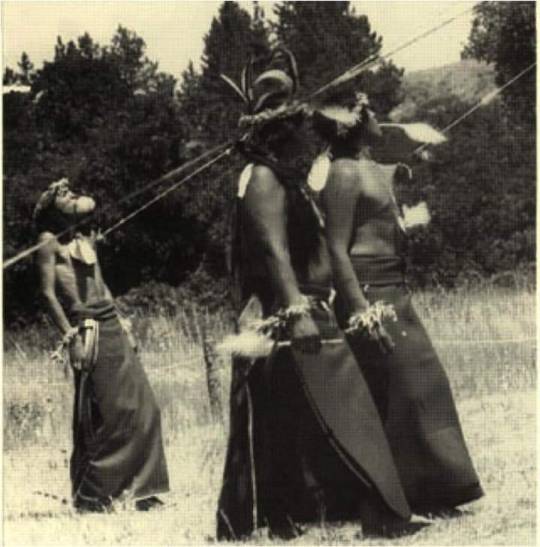

THE SUN DANCE ... ✊🏼❤️
Mythologies and Spirituality of our indigenous people of North America comprise of many bodies of traditional narratives associated with Spirituality from a mythographical perspective. Such spiritual stories are deeply based in Nature and are rich with the symbolism of seasons, weather, plants, animals, earth, water, sky and fire.
The principle of an all embracing, Mitakuye Oyasin, universal and omniscient Great Spirit, a connection to the Earth, diverse creation narratives and collective memories of our ancient ancestors are common. Traditional worship practices are a part of our tribal gatherings with dance, rhythm, songs and trance (The sun dance).
Wiwanke Wachipi - The Sun Dance
Sun Dance is the most important ceremony practiced by our Lakota (Sioux) and nearly all Plains Indians. It is a time of renewal for the tribe, oyate people and earth.
The village is large, as many bands come together for this annual rite. Each tribe camps within their own circle, which is part of another circle. A large circular arena is cleared, and a double ring of sticks is erected around the outside. Branches are placed on the top as shelter for the dancers, singers and spectators.
The Holy Men walk to the forest and select a large cottonwood tree to be used as the central pole. A man is selected because of a great deed or feat of bravery to count coup on the tree that is cut down. As it fell, it isn't allowed to touch the ground. The tree is then trimmed and taken back to the dance site, where it is decorated and erected in the middle of the arena.
The ceremony begins at sunrise the next day, and anyone can dance. Dancers look at the sun as they dance with short breaks without food and drink are allowed. This goes on for four days - usually while the self-sacrificers prepare themselves. Usually these men, as it is rare for a woman to participate, want something specific - good hunting skills, better fighting skills or healing powers.
Their bodies and spirits are purified through the Inipi ceremony before the dance. Each dancer has a mentor to help him through the ceremony. This would be a Holy Man or someone who had already danced.
The Holy Men prepare buffalo skulls and place them around the arena. Long lengths of rawhide are tied to the central pole. Dancers wear rings of sage on their heads and often around their wrists and ankles; each man carried a whistle made from the wing bone of an eagle.
As the dancers stand around the arena, the holy men approach them and pierced each side of their chests with a length of bone. Next, the rawhide thongs are attached to the bone. The dance begins with a slow shuffle.
Some chose not to be tethered to the pole. Instead, they have the bones pierced through their backs, and then buffalo skulls are attached with thongs. The dancers drag these heavy skulls around as they dance.
Purpose of the dance is to remove the bone pieces from the dancers body. Dancers at the pole pull themselves backwards, trying to tear their flesh and release themselves. Those with skulls attached to their backs dance over rocks and through bushes. They hope to catch the skulls on something and rip them from their bodies.
Dancers who have not released themselves close to sundown receive help from their mentors. The mentors grab their dancers from behind and jerk them backwards in an effort to tear the bones from the skin. If the dancer hasn't been released by sundown, the Holy Men removes the bones in reverse to the initial piercing.
Many Sun Dancers are traumatized and shocked by the experience. After the ceremony, we walk to the dancers lodge where medicine men care for us. Also in attendance are the Holy Men, singing their praises to the Gods and pray for us, the dancers, to recover swiftly. I then, awake.
The Lakota believe that everything has a spirit; including trees, rocks, rivers, and almost every natural being. This therefore leads to the belief in the existence of an afterlife.
We Lakota believe, Inyan, the Rock, was present at the very beginning, and so was the omni present spirit Wakan Tanka, the Great Mystery, and the darkness Han. Inyan wanted to exercise his powers, or compassion, so he created Maka (Earth Mother) as part of himself to keep control of his powers. But he sacrificed much of his blood by doing so, which becomes water, and he shriveled up, became hard, and begins losing his powers. The water (Mni Wiconi) cannot retain his powers, and Skan was created. Maka complained to Inyan that everything is cold and dark, and so he creates Anpao, the Dawn. As Anpao's red light was not enough for Maka, Inyan create Wi, the Sun.
Maka now wanted to be separate from Inyan, so he appealed to Skan, who is now the supreme judge of the universe. Skan then rules that Maka must stay bound to Inyan, which is why rocks are bound to soil. In another version, when Inyan created Maka, she taunted him for his impotence. Inyan appealed to Skan, and Skan banished Han to be under Maka. When Maka complained that she was too cold, Skan created Anpao and Wi to provide light and heat, and when Maka complained that she was too hot, Skan ordered that Han and Anp to follow each other around the world, thus creating day and night.
There are many myths surrounding the Blackfoot Native Americans as well as Aboriginal people. The Blackfeet inhabit areas of Alberta, Canada, and areas of Montana. These stories, myths, origins, and legends play a big role in their everyday life, such as their religion, their history, and their beliefs. Only the elders of the Blackfoot tribes are allowed to tell the tales. These myths are sometimes hard to get a hold of because the elders of the tribes are often reluctant to tell them to strangers who are not of the tribe.
There are several creation myths found within Native American culture; one of those is the creation myth involving Napioa. Napioa is mentioned in almost all Blackfoot myths and is considered an important figure in the Blackfoot mythology itself. Napioa is known by many names including the sun, Old man, and Napi (Nah-pee). Napioa is said to have created the earth using the mud from a turtle's mouth that was found on a river upon which napioa floated. He not only created the earth using the mud, but he also created the men and women as well. Napioa also made the bison as tame as ever for the people to hunt. He is said to also have created the animals and the grass and everything else that is on the earth.
Crow spirituality is the indigenous religion of the Crow tribe. One of many Crow creation stories for the physical world recalls that Old Man Coyote was alone in a large ocean when he saw two male ducks floating upon its surface. In conversation with the ducks the subject turns to what lies beneath the sea. Old Man Coyote encourages one of the ducks to dive, which he does, and after a nervous wait the duck finally surfaces with a root in its beak. Another dangerous dive brings up mud. With this soil Old Man Coyote builds first an island, and then all the lands of the Earth. However the Earth is empty, so Old Man Coyote uses the root to populate the planet with plants and trees.
Despite this success the Earth was still not right, it was too flat, so OMC shaped the land to create the rivers, mountains and all geographical features. Again something was missing, Old Man Coyote and the ducks wanted friends, so he moulded Man out of the clay. But Old Man Coyote wanted Man to be happy so he created Women too so that they may be contented together and multiply. He then made female ducks so that ducks may be happy too. The story then develops where Old Man Coyote encounters another Coyote, and they decide to travel together, getting themselves into various situations that eventually creates all animals of the Earth.
In the beginning it is believed that Crows were close to God, praying constantly to show their devotion, however as time progressed Crows forgot to pray and brought misfortune upon themselves. Crows believe that they must rekindle that bond through prayer if they are to be prosperous, many seeking a personal relationship with God to be individually successful.
Crows will often use ‘Grandmother Earth’ as a way of expressing the physical things that God created, as God, although part of the physical world, transcends the first world. Because of this God is often referred to hierarchically as being ‘Above,’ as in superior, rather than physically in the heavens. As God created everything Crows believe that the power of the Creator is in all things, and therefore, all things in nature are sacred.
As God created everything and is therefore omnipresent, Crows are in contact with God during every aspect of their daily lives. It is because of this omnipresence and omnipotence that Crows are religiously tolerant. One example of this tolerance is the overview of the world’s religions provided by Thomas Yellowtail, a Crow medicine man and Sun Dance chief. Yellowtail used the metaphor of a wagon wheel to describe religious belief, noting that, each spoke represented a unique people and religion. If one spoke was removed, the wheel would not work, meaning all spokes must be present to form the circle of life. All spokes however are connected to the central beam, the Creator.
Therefore, all religions and peoples are connected to God, and all equally valid as ways of establishing a spiritual relationship. As a result, Crows can participate in multiple religions, it is up to individuals to decide which methods they believe to be most effective.
Pawnee mythology is the body of oral history, cosmology, and myths of the Pawnee people concerning their gods and heroes. They traditionally speak Pawnee, a Caddoan language.
Atius Tirawa, which means "Father Above" in the Pawnee language (often translated, inaccurately, as "Great Spirit"), was the Creator god. He was believed to have taught the Pawnee people tattooing, fire-building, hunting, agriculture, speech and clothing, religious rituals (including the use of tobacco and sacred bundles), and sacrifices. He was associated with most natural phenomena, including stars and planets, wind, lightning, rain, and thunder. The wife of Tirawa was Atira, goddess of the Earth. Atira was associated with corn.
The solar and lunar deities were Shakuru and Pah, respectively. Four major stars were said to represent gods and were part of the Creation myth, in which the first human being was a girl. The male Morning Star and the female Evening Star mated to create her.
Tirawa conferred miraculous powers on certain animals. These spirit animals, the nahurac, would act as Tirawa's messengers and servants, and could intercede with him on behalf of the Pawnee. The nahurac had five dwellings or lodges:
The foremost among them was Pahuk, usually translated "hill island", a bluff on the south side of the Platte River, near the town of Cedar Bluffs in present-day Saunders County, Nebraska.
Lalawakohtito, or "dark island", was an island in the Platte near Central City, Nebraska.
Ahkawitakol, or "white bank", was on the Loup River opposite the mouth of the Cedar River in what is now Nance County, Nebraska.
Kitzawitzuk, translated "water on a bank", also known to the Pawnee as Pahowa, was a spring on the Solomon River: 358 near Glen Elder, Kansas. It now lies beneath the waters of Waconda Reservoir.
The fifth lodge of the nahurac was known to the Pawnee as Pahur, translated as "hill that points the way" or "guide rock".
The Pawnee seasonal rituals were tied to the observation of the stars and planets. Their earthwork lodges were built at the same time as observatories and as "microcosm" (scale-model of the universe). Each lodge "was at the same time the universe and also the womb of a woman, and the household activities represented her reproductive powers." The lodge also represented the universe in a more practical way.
The physical construction of the house required setting up four posts to represent the four cardinal directions, “aligned almost exactly with the north-south, east-west axis. A Pawnee observatory-lodge also required an unobstructed view of the eastern sky. The lodge's axis would be oriented east-west in such a way that the sunrise of vernal equinox would cast light on the altar. The dimensions of the lodge's smoke hola and door would be designed to allow observation of the sky, with the smoke-hole aligned to enable observation of the Pleiades.
According to one Skidi band Pawnee man at the beginning of the twentieth century, “The Skidi were organized by the stars; these powers above made them into families and villages, and taught them how to live and how to perform their ceremonies. The shrines of the four leading villages were given by the four leading stars and represent those stars which guide and rule the people.”
Regular ceremonies were performed before major events, such as semi-annual buffalo hunts, as well as before many other important activities of the year, such as sowing seeds in the spring and harvesting in the fall. The most important ceremony of the Pawnee culture, the Spring Awakening ceremony, was meant to awaken the earth and ready it for planting. It can be tied directly to celestial observation, held at the time when the priest first tracked "two small twinkling stars known as the Swimming Ducks in the northeastern horizon near the Milky Way."
G.v.Kirk.
15 notes
·
View notes
Text
Religious Studies Term Of The Day: Mitakuye Oyasin

Tried to make a cool gif but it didn’t work since it was too large for Tumblr, so here’s a picture of it instead!
14 notes
·
View notes
Text

Tokala Wicouncage
I was born to live in balance and harmony, brought from the ancestors to walk as a ikce wicasa on this beautiful unci maka.
But instead i was taught to own a square piece of land and put up a fence around it, and believe i owned that piece of grandmother.
I was shown anger, hate, jealosy and envy.
I was to believe that drinking alcohol and taking drugs/chemicals is how i make myself feel.
I learned to cry all the time, always walking with my eyes looking down, crying.
One day wakan tanka looking down decided to help me. He brought me from the drugs and drinking.
He showed me the canunpa and how to pray with it. I was shown all the beautiful values, that i am meant to be free and happy.
He showed me beautiful ceremonies to express my true natural self.
Beside me he would walk, he said.
So with creator I will live the rest of my days.
Mitakuye Oyasin.
Lena epa wacin, unsimakilayo.
5 notes
·
View notes
Text
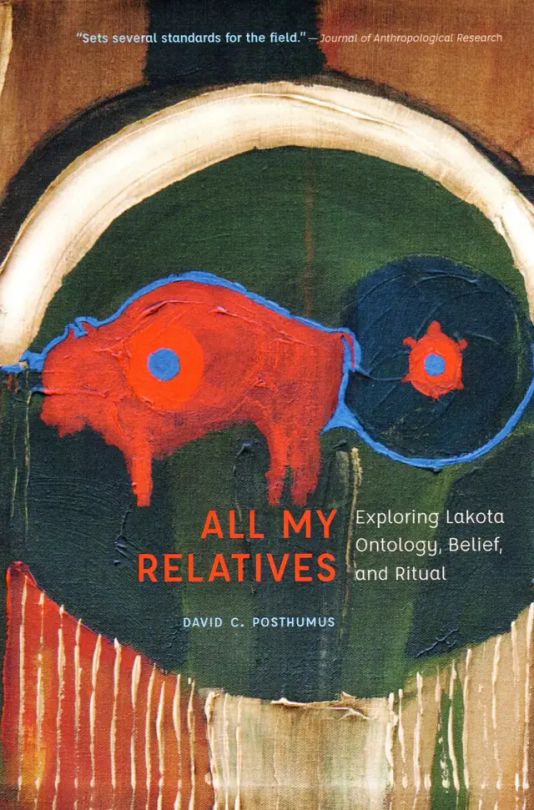

All my relatives: Exploring Lakota ontology, belief, and ritual. Posthumus DC (2022)
This is a book all about Lakota traditional beliefs and therefore has a lot of information connected to Mitakuye Oyasin. “At the heart of both Lakota religious continuity and innovation is an underlying animist ontological orientation, a basic way of seeing, understanding, and being in the world that extends personhood— in the form of a soul or spirit— to nonhuman life- forms.” This is expressed with ‘Mitakuye Oyasin’ –meaning ‘all my relatives’ or ‘we are all related’, which refers not only to human kinship but also to the relationship shared by all life-forms, both human and nonhuman, and the reciprocal obligations, responsibilities, and mutual respect that naturally extend from it” (14).
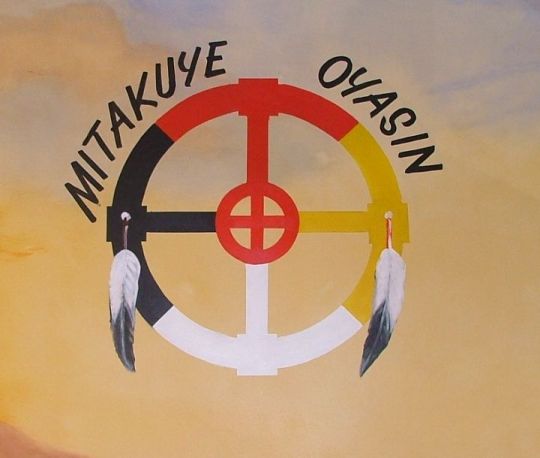
This repeats much of the ideas from similar definitions: belief in the connection between all life, relationships, the power the phrase has. It also gives a lot of words to help define these beliefs in academic language. Another important thing to point out is the way mitakuye oyasin is recognized as being part of Lakota innovation; my goal here is to use mitakuye oyasin to an innovation of queer ecology–hopefully add to the conversation.
“The normative cultural values encompassed by mitákuye oyásʾį are the very foundation of kinship, relational ontology, and the overarching interspecies collective, of which humans are only one hoop, one oyáte ‘people, nation, tribe’, in the company of many others. The key constituents of this animist ontology and worldview, of mitákuye oyásʾį, are persons, a category that extends beyond human beings to nonhuman or other- than- human persons. [...] Importantly, the Lakota worldview sees humans as the least knowledgeable and powerful beings, requiring the most aid and pity, upending the common Western biblical assumption that humans have dominion to rule over all other life- forms and subdue the earth (see V. Deloria 1999, 50; 2009, 99– 100). For the Lakotas, the seed of all life is wakʿą ‘sacrality, mystery, divinity’; ́ hence all life- forms share a generalized interiority, whether human or nonhuman.”

This is important information to support my argument. Queer ecology is very critical of Western beliefs and dichotomies that separate humans from nature and thereby present mankind as the ultimate lifeform (anthropocentrism). There are many essays and articles that examine the influence Christianity has had on the colonialist project (Gaard is the first that comes to mind). The Lakota worldview of being the ‘younger siblings’ of creation are supported by science in that ‘humans’ as a 'species' haven’t existed all that long in comparison to other 'species' and like many indigenous cultures, Lakota people knew the key to knowing nature was to learn from the world around us, as the author later confirms:
“Deloria explains that “the oldest traditions say that humans learned politeness and courtesy from the animals. . . . Generations of elders had already observed the behavior of birds . . . and decided that emulating them was the proper way for humans to act” (V. Deloria 2009, 123). Standing Bear (2006a, 56) substantiates this, writing, “The Lakota enjoyed his association with the animal world. For centuries he derived nothing but good from animal creatures. From them were learned lessons in industry, fidelity, and many virtues and much knowledge.” (50-51)
In the author’s footnotes is Vine Deloria’s examination of mitakuye oyasin that is, I feel, a great support of my claim:
“Vine Deloria refers to mitákuye oyásʾį as the ‘Indian principle of interpretation/observation,’ calling it “a practical methodological tool for investigating the natural world and drawing conclusions about it that can serve as guides for understanding nature and living comfortably within it. . . . We observe the natural world by looking for relationships between various things in it. . . . This concept is simply the relativity concept as applied to a universe that people experience as alive and not as dead or inert” (1999, 34). (Posthumus 2022 p219 f)
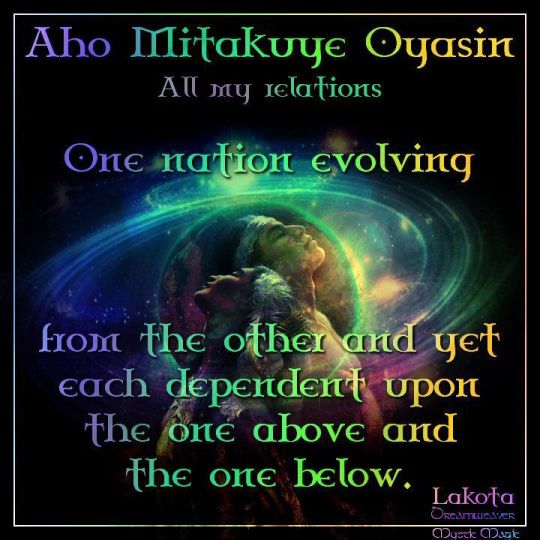
Queer ecology’s goal in many ways is to critique the ways the Western scientific paradigm has created inequity. Many are seemingly searching for solutions and answers to the problems that have been perpetuated by the colonial empire, supported as it is by western science.
While we must always, always be careful of appropriation and misappropriation–I contend that the solutions are not ones that need to be ‘discovered’ or solved in the way that Western science is so often searching for–advancement, the future…but rather, the answers are in what has always been there…and it’s simply a matter of observation.
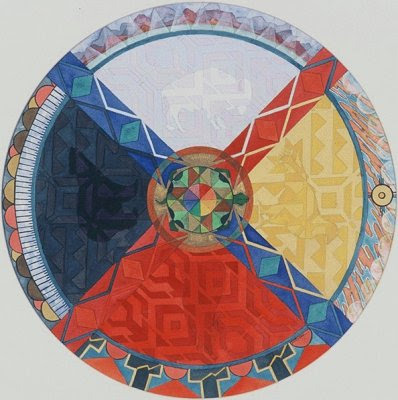
#queer ecology#mitakuye oyasin#queer theory#ecofeminism#critical ecology#colonialism#all my relatives#lakota#indigenous studies#postcolonial theory#ecology#science#traditional ecological knowledge#queering ecology#ecosystems#environment#social ecology#long post
22 notes
·
View notes
Text
Native American Spirituality: A Path of Harmony with the Earth
In a world facing pressing environmental challenges, the need for a sustainable and holistic approach to our relationship with the planet has become increasingly apparent. Native American spirituality offers a unique perspective that emphasizes a deep connection and reverence for the Earth. In this blog post, we will explore why Native American religion stands out as a path that holds valuable lessons for humanity's harmonious coexistence with nature.
1 - Ecological Wisdom: Native American religions have long recognized the interconnectedness of all living beings and the environment. They view nature as a sacred and interconnected web of life, where every entity, from animals and plants to rivers and mountains, possesses inherent value and deserves respect. This ecological wisdom teaches us the importance of living in harmony with the Earth and embracing sustainable practices that honor the delicate balance of ecosystems.
Example: The Navajo people's belief in the interconnectedness of all things is reflected in their concept of "Hózhǫ́ǫ́gįį́," which encompasses beauty, balance, harmony, and health. It promotes living in alignment with the natural world, acknowledging the interconnectedness of all living beings and the responsibility to maintain harmony within the environment.
2 - Stewardship and Conservation: Native American spirituality emphasizes the role of humans as stewards of the Earth rather than dominant rulers. The concept of stewardship recognizes our responsibility to protect and preserve the natural world for future generations. Many Native American tribes have traditionally practiced sustainable land and resource management, showing respect for the Earth's gifts and ensuring their responsible use.
Example: The Iroquois Confederacy's Great Law of Peace emphasizes the importance of considering the well-being of future generations in decision-making. This principle reflects a deep respect for the environment and a commitment to ensuring the continuity and sustainability of resources.
3 - Rituals and Ceremonies: Native American religions often incorporate rituals and ceremonies that foster a connection with nature and express gratitude for the Earth's abundance. These practices serve as reminders of our interconnectedness with the natural world and help cultivate a sense of reverence and respect for the environment.
Example: The Sun Dance ceremony, practiced by various Plains tribes, symbolizes renewal and the cycle of life. It involves fasting, prayer, and dancing in harmony with nature, reinforcing the bond between humans and the Earth.
4 - Spirituality in Everyday Life: Native American spirituality emphasizes the integration of spiritual beliefs into everyday life. It encourages a deep sense of awareness, gratitude, and mindfulness towards the natural world. This approach nurtures a profound respect for the Earth and fosters a sustainable way of living in harmony with nature.
Example: The concept of "Mitakuye Oyasin" among the Lakota people expresses the belief that all beings are interconnected and part of the same spiritual family. This understanding inspires a sense of responsibility and care for the well-being of all creatures and the environment.
Native American spirituality offers a valuable perspective on our relationship with the Earth, emphasizing ecological wisdom, stewardship, and a deep reverence for the interconnectedness of all life. By embracing these teachings and integrating them into our lives, we can cultivate a harmonious and sustainable approach to coexisting with the planet. The wisdom and practices of Native American religions serve as a profound source of inspiration and guidance as we navigate the environmental challenges of our time and strive to create a better future for generations to come.
#Native American spirituality#Environmental harmony#Ecological wisdom#Stewardship and conservation#Interconnectedness of life#Sustainability practices#Indigenous traditions#Rituals and ceremonies#Mindfulness in nature#Cultural diversity#Reverence for the Earth#Indigenous wisdom#Environmental responsibility#Harmony with nature#Interconnected spirituality#Sustainable living#Lessons from Native American traditions#Environmental consciousness#Spirituality and the environment#Cultivating reverence for the Earth#knowledge#learning#ethics#education#chatgpt#philosophy#epistemology#spirituality
6 notes
·
View notes
Photo
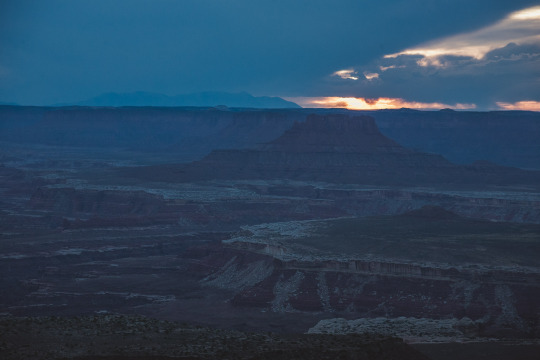
© 2022 All Rights Reserved
Indigenous peoples have a phrase, Mitakuye Oyasin, that loosely translates to ‘interconnectedness.’ The connection between themselves and others, their connection with the land.
2 notes
·
View notes
Text
“My grandma told me that the Universe is singing in the snowflakes, the raindrops, in the trees, the water, and all Creation. Physicists call this holistic holographic universe. Lakotas call it Taku Wakan Skan Skan/Mitakuye Oyasin, which means everything is connected and related in divine rhythm, vibration. Remember the Lakotas know that the song sings the singer. The Spirit sings the song.”
— Basil Braveheart

2 notes
·
View notes
Text
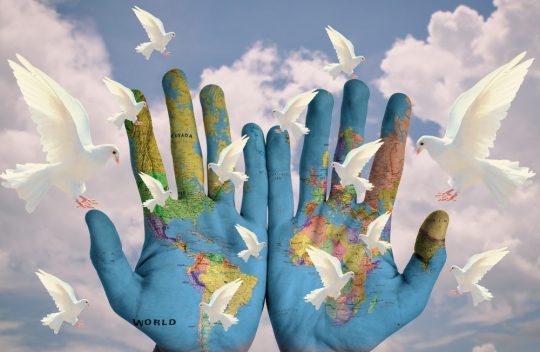
prière de gratitude, d'union harmonieuse et joie multidimentionnel

Aho, Mitakuye Oyasin… Toutes mes relations, je vous honore dans ce cercle de vie avec moi aujourd'hui. Je suis reconnaissant pour cette opportunité de vous reconnaître dans cette prière….
Au Créateur, pour le don ultime de la vie, je te remercie.
À la nation minérale qui a construit et entretenu mes os et tous les fondements de l'expérience de vie, je vous remercie.
À la nation végétale qui soutient mes organes et mon corps et me donne des herbes médicinales pour la maladie, je vous remercie.
À la nation animale qui me nourrit de votre propre chair et offre votre fidèle compagnie dans ce domaine de la vie, je vous remercie.
À la nation humaine qui partage mon
chemine une âme sur la roue sacrée de la vie terrestre, je vous remercie.
À la nation spirituelle qui me guide de manière invisible à travers les hauts et les bas de la vie et pour avoir porté le flambeau de la lumière à travers les âges, je vous remercie.
Aux quatre vents du changement et de la croissance, je vous remercie.
Vous êtes tous mes parents, mes proches, sans qui je ne vivrais pas. Nous sommes dans le cercle de la vie ensemble, coexistant, co-dépendants, co-créant notre destin. L'un, pas plus important que l'autre. Une nation évoluant à partir de l'autre, et pourtant chacune dépendante de celle d'en haut et de celle d'en bas. Nous faisons tous partie du Grand Mystère.
Merci pour cette Vie.
————
Mitakuye Oyasin ~ Ces deux mots signifient "Toutes mes relations" ou "Nous sommes tous liés". Prier cette prière, c'est demander à Dieu au nom de tout le monde et de tout sur Terre. Mitakuye Oyasin honore le caractère sacré du chemin spirituel individuel de chaque personne, reconnaît le caractère sacré de toute vie (humaine, animale, végétale, etc.) et crée une énergie de conscience qui renforce non seulement la personne qui prie mais la planète entière.
______________________________________________________
"Essaime l'air par l'onde provenant du coeur"
7 notes
·
View notes
Text
Anpetu Was’te
TUPE Students
Here is your cultural article for today.
Mitakuye Oyasin
Kathy Willcuts -Lakota
TUPE Cultural Educator
Julie DePhilippis-Aleut
TUPE Youth Coordinator
0 notes
